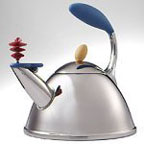
Vol. III, No. 8, September 2003
- From the Editor
- Luxury for the Masses
- Faith Popcorn Defines Today's Kids
- An Educated Society Seeks Enrichment & Edutainment
- Randy White to Present at Fun Expo
- Foundations Entertainment University
- The Challenge of Cost Estimating & Bringing a Project in On Budget
- That's Eatertainment White Paper
- Set Your Opt-In Spam Filters
- New Projects
Luxury for the Masses

Target's Michael Graves designed teakettle
In past issues we have discussed how the bar has been raised (and continues to be raised) for location-based leisure facilities (LBLs) with such things as quality of food and beverage offerings, ambiance and décor, or what we call quality-of-place. Put simply, guests' expectations have grown, due to the rising standards at other consumer destinations, such as retail stores, restaurants and cinemas. We have often used Panera Bread Company as an example of this phenomenon, citing the rapid growth of its highly successful concept of serving freshly prepared food on real china in a mid-upscale environment, and at a price point about 50% higher than its fast food competition. Other examples are JetBlue airline with leather seats and 24-channel TVs at economy class fares, the famous service at discount Southwest Airlines, Target's Michael Graves designed affordable-yet-high end products, and the Starbucks chain.
This phenomenon has a number of names. Yankelovich Inc, a leading consumer market research company, calls it the mainstreaming of affluence. Advertising professor James Twitchell at the University of Florida calls it the democratization of luxury. BCG consultants Michael Silverstein and Neil Fiske characterize it as new luxury or luxury for the masses.
Whatever you call it, the trend boils down to average consumers wanting to experience luxury and believing they deserve it. Today's consumers have come to expect the very best.
Consumers now take for granted that everything should cater to their highest expectations. This attitude extends not just to products, but also to services -- in other words, to the entire consumer experience.
So if other consumer products and destination businesses are offering luxury for the masses, where does this leave the location-based leisure industry? LBLs basically sell experiences. In today's marketplace, they'd better offer exceptional experiences, or they'll be perceived as inferior, based upon consumers' rising expectations. What worked 10 years ago with LBLs, whether it was the ambiance, the presentation of entertainment, the service, the food and beverage, or whatever, could well result in road kill today.
Sure, it costs more to do it right by today's standards, to provide an experience that meets, or better yet, exceeds consumers' expectations. But in the long run, exceeding consumers' expectations generates the highest return and assures long-term success for your business. Do any less, and you're toying with failure. The bar has been raised, and for LBLs to compete and succeed today requires playing by a whole new set of rules.
For a number of years, we at White Hutchinson have been aware of this phenomenon and have been creating family entertainment centers (FECs), children's edutainment centers and other leisure destinations that meet and exceed contempory contemporary consumers' expectations. Our philosophy is to make our clients successful, not just to get their business. We understand the basic equation for our clients' success with LBLs: Please the guests and get them to return again and again. Today, that means designing and operating LBLs to meet the values of new luxury.
Vol. III, No. 8, September 2003
- From the Editor
- Luxury for the Masses
- Faith Popcorn Defines Today's Kids
- An Educated Society Seeks Enrichment & Edutainment
- Randy White to Present at Fun Expo
- Foundations Entertainment University
- The Challenge of Cost Estimating & Bringing a Project in On Budget
- That's Eatertainment White Paper
- Set Your Opt-In Spam Filters
- New Projects


